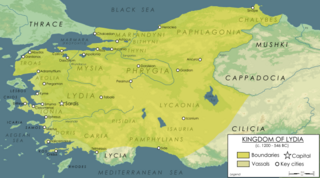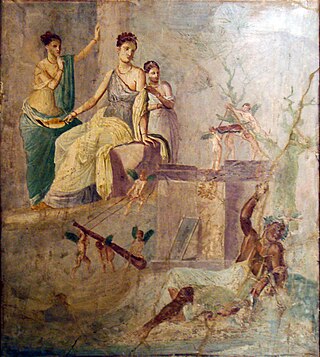Related Research Articles

Alyattes, sometimes described as Alyattes I, was the fourth king of the Mermnad dynasty in Lydia, the son of Sadyattes, grandson of Ardys, and great-grandson of Gyges. He died after a reign of 57 years and was succeeded by his son Croesus.

Lydia was an Iron Age kingdom situated in the west of Asia Minor, in modern-day Turkey. The ethnic group inhabiting this kingdom are known as the Lydians, and their language as Lydian and their capital was Sardis.
This article concerns the period 639 BC – 630 BC.

Croesus was the king of Lydia, who reigned from 585 BC until his defeat by the Persian king Cyrus the Great in 547 or 546 BC. According to Herodotus, he reigned 14 years. Croesus was renowned for his wealth; Herodotus and Pausanias noted that his gifts were preserved at Delphi. The fall of Croesus had a profound effect on the Greeks, providing a fixed point in their calendar. "By the fifth century at least", J. A. S. Evans has remarked, "Croesus had become a figure of myth, who stood outside the conventional restraints of chronology."

Gyges was the founder of the Mermnad dynasty of Lydian kings and the first known king of the Lydian kingdom to have attempted to transform it into a powerful empire. Gyges reigned 38 years according to Herodotus.

In Greek mythology, Omphale was queen of the kingdom of Lydia in Asia Minor. Diodorus Siculus provides the first appearance of the Omphale theme in literature, though Aeschylus was aware of the episode. The Greeks did not recognize her as a goddess: the undisputed etymological connection with omphalos, the world-navel, has never been made clear. In her best-known myth, she is the mistress of the hero Heracles during a year of required servitude, a scenario that, according to some, offered writers and artists opportunities to explore sexual roles and erotic themes.
Sadyattes was the third king of the Mermnad dynasty in Lydia, the son of Ardys and the grandson of Gyges of Lydia. Sadyattes reigned 12 years according to Herodotus.

Candaules, also known as Myrsilos (Μυρσίλος), was a king of the ancient Kingdom of Lydia in the early years of the 7th century BC. According to Herodotus, he succeeded his father Meles as the 22nd and last king of Lydia's Heraclid dynasty. He was assassinated and succeeded by Gyges.

The Lydians were an Anatolian people living in Lydia, a region in western Anatolia, who spoke the distinctive Lydian language, an Indo-European language of the Anatolian group.
Lydus, a son of Atys and Callithea, grandson of Manes, and brother of Tyrrhenus or Torybus, is a legendary figure of the 2nd millennium BC who is attested by Herodotus to have been an early king of Lydia, then probably known as Maeonia. According to Herodotus, the country of Lydia and its people were afterwards named for Lydus, their mythical ancestor.
Manes is a legendary figure of the 2nd millennium BC who is attested by Herodotus in Book One of Histories to have been an early king of Lydia, then probably known as Maeonia. He was believed to have been the son of Zeus and Gaia, and was the father of Atys, who succeeded him as king. Atys, through Callithea, fathered Lydus, after whom the Lydian people were later named, and Tyrrhenus, after whom the Tyrrhenians were named. Later, in Book Four, Herodotus states that Manes had another son called Cotys, who, through Halie, had a son called Asies, after whom the Lydians claimed that the continent of Asia is named. Dionysius of Halicarnassus names Callirhoe, daughter of Oceanus, as the mother of Cotys by Manes, and Atys as the son of Cotys.
Agron was a legendary king of Lydia who is named by Herodotus as the first of the Lydian Heraclid dynasty. His father is named by Herodotus as Ninus ,the mythical founder of Nineveh and a descendant of Šanta,an Assyrian sun god
Meles was a semi-historical king of Lydia. According to Herodotus, he was the 21st and penultimate king of the Heraclid dynasty and was succeeded by his son, Candaules.
Ardys was the son of Gyges of Lydia, whom he succeeded as the second king of the Mermnad dynasty.
Sandakshatru or Sandakuru was the last known Cimmerian king.
Treri is the name of a Thracian tribe.
Atys is a legendary figure of the 2nd millennium BC who is attested by Herodotus to have been an early king of Lydia, then probably known as Maeonia. He was the son of Manes and the father of Lydus, after whom the Lydian people were later named.
In Greek mythology, Tyllus is an Autochthon of Lydia. He was the father of Halie, who married Cotys, an early king of Lydia. Tyllus is attested by only one author: Dionysius of Halicarnassus, in his Roman Antiquities. However, the same family tree of the early Kings of Lydia can be in Herodotus and Xanthus.

The Lydian–Milesian War was a military conflict between the Kingdom of Lydia and the ancient Greek city state of Miletus. It took place during the 7th century BC in the Archaic period, traditionally set between 612 and 600 BC. The main source of the war is Herodotus, who wrote about it in the opening chapters of his Histories. The war ended after 12 years when the tyrant of Miletus, Thrasybulus of Miletus, convinced the Lydian king Alyattes to sue for peace with a ruse, after which an alliance between the two states was forged. Amongst other things, the length of the war has caused debate among modern historians.

Bin Tepe is an archaeological site on the southern shore of Marmara Lake in Manisa Province, Turkey. Consisting of over 100 tumuli, it served as a cemetery for the elites of nearby Sardis.
References
- 1 2 Herodotus & de Sélincourt 1954 , p. 80
- ↑ Greek Mythology Link: Tantalus Archived 2007-01-06 at the Wayback Machine
- ↑ "Theoi Project Guide to Greek Mythology: Plouto". Theoi.com. 2017. Retrieved 30 June 2018.
- ↑ Dionysius of Halicarnassus. Roman Antiquities. 1.27.1.
- ↑ Rawlinson, George (1875). The History of Herodotus: A New English Version, Ed. with Copious Notes and Appendices, Illustrating the History and Geography of Herodotus, from the Most Recent Sources of Information; and Embodying the Chief Results, Historical and Ethnographical, which Have Been Obtained in the Progress of Cuneiform and Hieroglyphical Discovery. Volume 1: On the Life and History of Herodotus. D. Appleton and Company. pp. 279–280. Retrieved 20 April 2020.
- ↑ Herodotus & de Sélincourt 1954 , pp. 43, 80
- 1 2 3 4 5 6 7 8 9 Herodotus & de Sélincourt 1954 , p. 43
- ↑ Herodotus & de Sélincourt 1954 , pp. 43–44
- 1 2 3 Bury & Meiggs 1975 , p. 82
- ↑ Herodotus & de Sélincourt 1954 , pp. 43–46
- ↑ Compendium of World History: Homer and the Lydian Kings
- ↑ Encyclopaedia of the Orient: Lydia
- ↑ Livius Articles on Ancient History: Mermnad dynasty
- 1 2 Yakubovich, Ilya (2017). "An Agreement between the Sardians and the Mermnads in the Lydian Language?". Indogermanische Forschungen. 122 (1): 265–294. doi:10.1515/if-2017-0014. S2CID 171633908 . Retrieved 13 November 2021.
- ↑ Bury & Meiggs 1975 , pp. 82–83
- ↑ Lendering, Jona (2003). "Gyges of Lydia". Livius. Retrieved 26 October 2021.
- 1 2 Spalinger, Anthony J. (1978). "The Date of the Death of Gyges and Its Historical Implications". Journal of the American Oriental Society. 98 (4): 400–409. doi:10.2307/599752. JSTOR 599752 . Retrieved 25 October 2021.
- 1 2 3 4 Dale, Alexander (2015). "WALWET and KUKALIM: Lydian coin legends, dynastic succession, and the chronology of Mermnad kings". Kadmos. 54: 151–166. doi:10.1515/kadmos-2015-0008. S2CID 165043567 . Retrieved 10 November 2021.
- ↑ Wallace, Robert W. (2016). "Redating Croesus: Herodotean Chronologies, and the Dates of the Earliest Coinages". The Journal of Hellenic Studies. 136: 168–181. doi:10.1017/S0075426916000124. JSTOR 44157500. S2CID 164546627 . Retrieved 14 November 2021.
- ↑ Herodotus & de Sélincourt 1954 , pp. 43–48
- ↑ Bury & Meiggs 1975 , p. 144